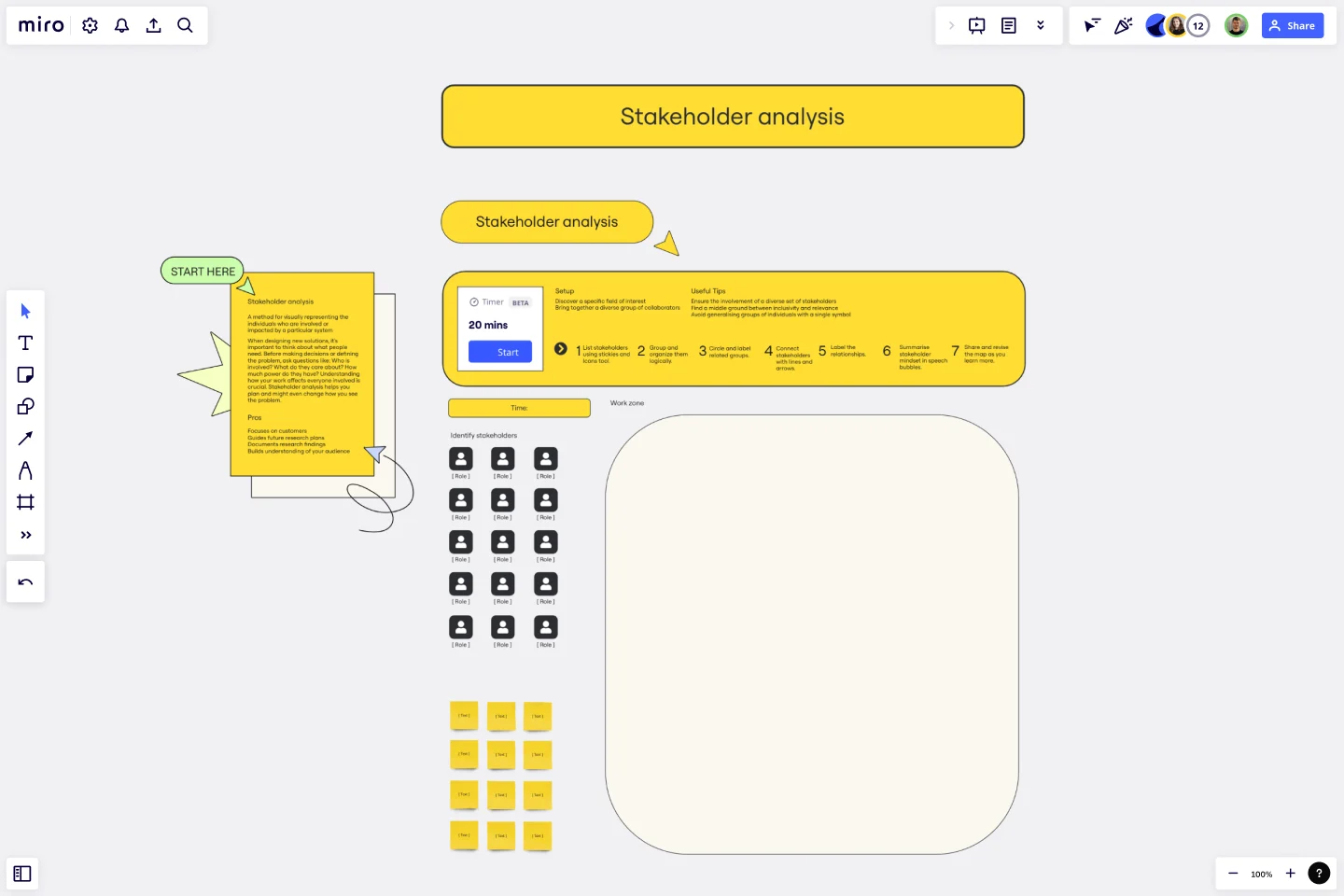Stakeholder Analysis Template
Represent the people involved or impacted by a system with the Stakeholder Analysis Template.
About the Stakeholder Analysis Template
When designing new solutions, it is essential to take a detailed and comprehensive approach that considers the needs and requirements of all stakeholders involved. Before making any decisions or defining the problem, it is crucial to conduct a thorough analysis that considers various factors, such as the identity of the stakeholders, their concerns and priorities, and the level of influence they wield.
Understanding how your work affects everyone involved is vital to the success of your project. By conducting a stakeholder analysis, you can better understand the various perspectives and interests and use this information to plan and strategize more effectively.
Stakeholder analysis can be a powerful tool that helps you plan and leads to a paradigm shift in your approach to the problem. By taking the time to understand the needs and requirements of all stakeholders involved, you can create solutions that are more effective, efficient, and sustainable in the long run.
Benefits of using the template
Focus on customers.
Guide future research plans.
Document research findings.
Build an understanding of your audience.
How to use the template in Miro
List stakeholders using stickies and Icons tool.
Group and organize them logically.
Circle and label related groups.
Connect stakeholders with lines and arrows.
Label the relationships.
Summarise stakeholder mindset in speech bubbles.
Share and revise the map as you learn more.
Setup
Discover a specific field of interest.
Bring together a diverse group of collaborators.
Useful tips
Ensure the involvement of a diverse set of stakeholders.
Find a middle ground between inclusivity and relevance.
Avoid generalizing groups of individuals with a single symbol.
Get started with this template right now.
UX Research Repository Template
Works best for:
UX Design, User Experience
Empower your organization with customer knowledge and build a centralized research hub. From UX designers to product managers, enable everyone to get insights using the Research Repository Template.
Darts Template
Works best for:
Design
It is a common mistake to assume that all ideas, tasks, or features are equally important. However, in order to achieve the best results and focus on the most critical elements, it is necessary to determine what takes priority. This approach allows you to prioritize and concentrate on what requires immediate attention while postponing the remaining aspects for later. The Darts Template is designed to limit the amount of content that can be placed in the center, forcing your team to consider priorities before taking any action.
UX Project Canvas Template
Works best for:
User Experience, UX Design, Market Research
Inspired by Alexander Osterwalder's 2005 business model canvas, the project canvas will help your team visualize the big picture of your UX and design projects, providing a convenient structure that holds all of your important data. This innovative tool enables you to transform an idea into a project plan, stimulating collaboration and communication between collaborators. Unlike alternative models, the project canvas is a simple interface. There are few startup costs, and employees can easily be brought up to speed to start using the canvas quickly.
User Empathy Map
Works best for:
Market Research, Research & Design
User Empathy Map template helps you visualize user experiences and needs. It’s an essential tool for teams looking to design products that resonate with their users. Use this template to build empathy and improve user satisfaction.
Co-Creation Template
Works best for:
Design
The Co-Creation Template enables the visual expression of ideas using essential elements. Analysis of these creations identifies explicit and implicit needs. For instance, a human resources team may use symbols to envision their ideal work environment. The output reflects people's desires and expectations.
Empathy Map for Food Ordering App
Empathy Map template aids in visualizing your users' experiences. It helps teams understand what users see, think, and feel, ensuring your product meets their needs. This tool is essential for building empathy and designing better user experiences.
